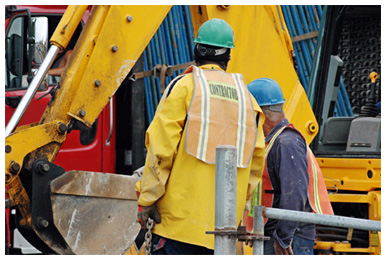Construction Worker Helps Police Catch NYC ShooterThe Construction Citizen team often pauses to pay tribute to the heroes of this industry, but a construction worker from New York took things to a whole new level this past week. Police say that when gunshots rang out near the Empire State Building, leaving one man dead, a construction worker named Brian Dillon sprang into action to help catch the shooter.“Someone like that isn’t supposed to walk the street,” Dillon told the New York Daily News.After the last shot was fired, the accused shooter, Jeffrey Johnson, started to casually walk away. That’s when Dillon bolted from the loading dock where he had been working to follow Johnson.Dillon was afraid Johnson would blend into the crowd, so he followed closely and flagged down a couple of police officers. Johnson then pulled out his gun again, and the officers shot and killed him. While police don’t recommend that citizens pursue criminals, they believe Dillon is a hero.



There’s a major shift in the way the federal government is enforcing labor laws. The United States Department of Labor isn’t just making sure general contractors follow the law, but those companies have now been put on notice that they’ll be held accountable for the actions of the subcontractors as well.The Labor Department has announced a settlement with Lettire Construction Corporation and its President and Chief Executive Officer, New York contractor Nicholas Lettire, who are going to have to pay out about $960,000 in back wages and benefits for workers employed by subcontractors. A lengthy investigation showed that many of those workers were not being paid prevailing wages, overtime they should have received, or benefits.In a press release from the Department of Labor’s Wage and Hour Division, deputy administrator Nancy J. Leppink said:“The settlement makes absolutely clear that responsibility for complying with the federal prevailing wage laws rests with Lettire Construction and Nicholas Lettire,
August 06, 2012


The decline of the way Americans value skilled labor, which we've chronicled extensively on Construction Citizen, can be seen in different ways all around us.Louis Uchitelle makes the point brilliantly in a New York Times article in which he describes how hardware stores are having to find ways to cater to people who don't know how to “do it themselves”, so to speak. Even signs adorning the walls and aisles at a Home Depot serve as instructions for simple things like how to fix a faucet or replace light bulbs.A question often asked by citizens and politicians alike: “Why don't we make anything in America anymore?”Uchitelle argues that the decline in American craftsmanship runs parallel to that of our manufacturing sector. He points out that in the 1950s, manufacturing accounted for 28 percent of GDP (gross domestic product). That has now fallen to 12 percent.
July 25, 2012


“Even students who major in programs shown to increase earnings ... face limits on how much debt they can sanely amass. And with costs approaching $60,000 a year for many private schools and $30,000 for state schools, six-figure student loan debt is fast becoming the norm.” – Glenn Harlan Reynolds
July 09, 2012


A great article in a small publication points out that employers around the Great State aren’t just anticipating a labor shortage, they’re already feeling it.Community Impact Newspaper reports that employers are already having trouble finding people for jobs like plumbing, pipefitting, electricians and machinists. At a recent meeting of business leaders with Texas Comptroller Susan Combs, a man who manufactures furniture in San Marcos put it bluntly: “I couldn’t find an employee in this town if my life depended on it.”In the article, Combs remarks on welding jobs in Texas: “Right now you can’t hire a welder. We’re about 500 to 1,000 [employees] short.”
July 05, 2012


The coming labor shortage we’ve reported on extensively at Construction Citizen isn’t confined to the United States. Germany, an economic powerhouse like Texas, now has its economic performance threatened because the country’s businesses can’t find enough skilled laborers.If this doesn’t drive home the point, perhaps nothing will: The head of Germany’s Labor Office, Frank-Jürgen Weise, says “the skills squeeze could hinder the German economy more than the debt crisis”, according to an article in International News publication the Global Post.Among the biggest reasons for the shortage: A failure to educate enough young people to meet industry’s needs. The Global Post article quotes Stefan Hardege, head of the German Chamber of Commerce's labor market unit, as stating: “Every third company we surveyed said that they saw the skills shortage as one of the biggest risks to the development of their business over the next 12 months.” Weiss also predicted that by the year 2025, Germany will be short on labor to the tune of about 3 million workers.
July 03, 2012


The fact that more than 12 million Americans are without work while employers simultaneously face a labor shortage has become a fascination for me. Every time I write about it, people ask “How is this even possible?”Employers are struggling right now to fill jobs that require skilled (or talented) workers,according to a survey by Manpower Group. Half the employers told Manpower they have trouble finding people to fill positions.American companies aren’t the only ones with this problem. Thirty-five percent of companies worldwide said they have real difficulty finding talented individuals to fill the jobs they’re advertising.
June 28, 2012


Around the country, more local and state leaders are starting to understand that there has to be a proactive approach to dealing with the impending labor shortfall. The shortage is already starting to hit some builders and other businesses in Texas, and it will only get worse if current trends hold.In Georgia, they’ve started a program to address this called “Go Build Georgia”. It includes big-time promotion from big-name talent: Mike Rowe of Mike Rowe Works and Discovery Channel’s “Dirty Jobs”. State and industry leaders are working together with educators to try to get kids excited about the idea of a career in the skilled trades.Governor Nathan Deal’s office put together some statistics that are truly alarming, including:
June 19, 2012


The debate over whether every child in Texas and America should be on a track to go to a four-year university is heating up. The arguments for and against have been passionate as youth unemployment hits a 60-year high and student-loan debt approaches $1 trillion (and default rates are rising quickly).“These hard economic times have made it even more difficult for student borrowers to repay their loans, and that’s why implementing education reforms and protecting the maximum Pell grant is more important than ever,” said U.S. Secretary of Education Arne Duncan.Given all this, more people are asking whether the “college-for-all” mantra is having an effect that amounts to the opposite of what was originally intended.Forbes contributor Tara Tiger Brown asks: “What is America going to do without skilled workers who can build and fix things?” She laments the “death of shop class” in California and around the nation. She writes:“There is no training for teachers going through university to learn how to teach shop. This trend isn’t limited to California, according to John Chocholak who has testified in front of California State Assembly and Congress on the subject of shop class.
June 12, 2012


State Senator Dan Patrick’s push to end the “college for everyone in Texas” policy has sparked an interesting debate. Patrick (R-Houston) may be the incoming Chairman of the Senate Education Committee and says the de-emphasis on vocational training and over-emphasis on getting everyone into a four-year institution of higher learning isn’t working. He recently stated:“Part of our dropout rate is because a lot of students who are very bright and have a lot of skills and a lot of talent get to a physics course or some exam or some class that knocks them out.”The same debate is playing out across the nation. Results of extensive research on the subject
June 07, 2012


